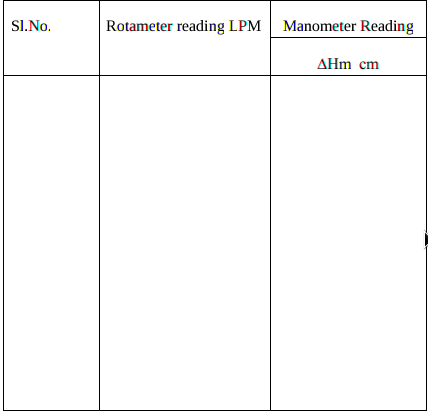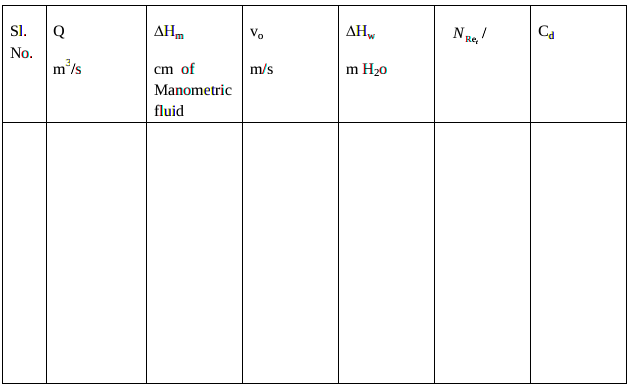Flow through Venturi meter
Apparatus required :
CCL4 manometer, Hg manometer.
Procedure :
- Keep the bypass valve completely open and the main valve completely closed. Switch on the pump.
- Connect a CCL4 manometer, Hgmanometer across the venturi.
- Open the main valve and set a flow rate of water using the rotameter.
- Note down the rotameter reading and manometer reading after a steady state is attained.
- Increase the flow rate by opening the main valve and throttling the bypass valve suitably and repeat step 4.
- Use mercury manometer for higher flow rates.
- Take readings with CCL4 manometer, Hg manometer as well as with Hg manometer.
- Repeat the experiment with different
.gif) ratios and with different fluids.
ratios and with different fluids.
Data :
Diameter of the pipe = d = cm
Diameter of the venture throat= dt= cm
Density of CCL4 =.gif) CCL4 = kg/m3
CCL4 = kg/m3
Density of Hg =.gif) Hg = kg/m3
Hg = kg/m3
Density of fluid =.gif) = kg/m3
= kg/m3
Viscosity of fluid = .gif) = cp
= cp
Observations :

Calculations :
Flow rate:
.gif) Hm= cm of manometric fluid.
Hm= cm of manometric fluid.
Volumetric flow rate = Q = m3/s
.gif) = m of H2o
= m of H2o
.gif) m= density of manometric fluid.
m= density of manometric fluid.
Average velocity through the throat =Vt=Q/At= m/s
At = Cross sectional area of throat = 
.gif) =dt/d=
=dt/d=
Reynolds Number at the throat = <img src="images/CodeCogsEqn126.gif"style="width:101px;height:42px"> =
Coefficient of discharge = Cd = 

Plot Q vs
.gif) and Q vs
and Q vs .gif) on ordinary graph(calibration).
on ordinary graph(calibration).Plot Cd vs NRet on a semilog graph sheet (with NReton log scale).
Plot log Q vs log .gif) .Find the slope and the intercept. Find the coefficient and power of
.Find the slope and the intercept. Find the coefficient and power of
.gif) . Comment on the nonlinear flow head relationship. Obtain Cd from the plot.
. Comment on the nonlinear flow head relationship. Obtain Cd from the plot.
Results :
- Report on calibration
- Comment on Cd vs NRet
- Report the Cd
- Comment on flow head relationship
- compare Cd for orifice and venturimeter
